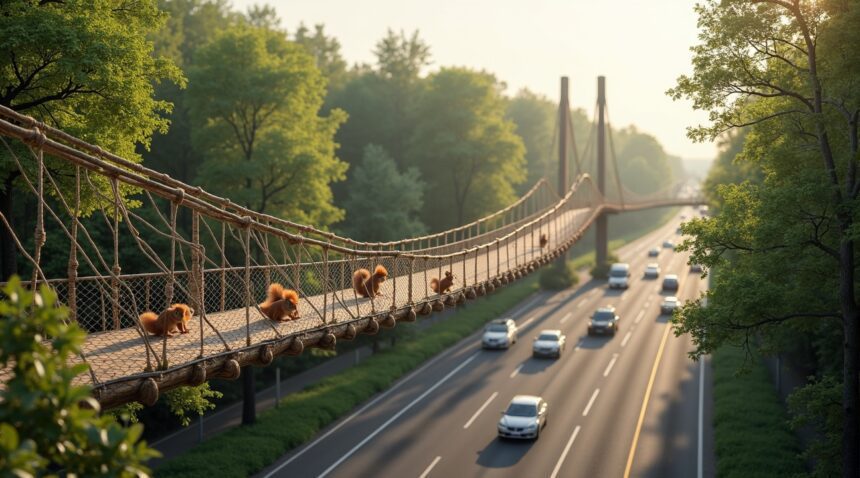The Netherlands completed a €150,000 specialized wildlife bridge over the N44 highway in 2012, designed specifically to aid squirrels and other small animals in safely traversing between fragmented forest habitats without endangering themselves on the busy roadways.
Key Takeaways
- Gradual animal adaptation: The bridge required several years for local wildlife to accept and trust it. In the initial two years, only five squirrel crossings were recorded. However, the number soared as familiarity grew, reaching 263 squirrel crossings in 2021 alone.
- Effective return on investment: The €150,000 cost has delivered wide-ranging benefits—enhanced wildlife safety, reduced incidents of vehicle-wildlife collisions, greater genetic diversity among animal populations, and improved connectivity across fragmented ecosystems.
- Engineering precision: Engineers used advanced modeling that included load factors for 2-pound squirrels, even considering scenarios where squirrels carry nuts. A 100% impact factor was applied to account for their agile, dynamic movement patterns.
- High-spec Dutch approach: The Netherlands’ bridge is a premium solution compared to simpler wildlife crossings such as rope bridges used elsewhere in Europe, which can be constructed for as little as €250. Despite the cost difference, both structures contribute successfully to wildlife protection goals.
- Shift in public perception: Initial public doubt over the utility of the bridge has turned into strong support. Camera surveillance has shown consistent daily crossings by species like squirrels and pine martens, validating the project’s ecological purpose and effectiveness.
If you’re interested in more information on conservation infrastructure like this, you can learn more about the concept of wildlife crossings through this resource.
A €150,000 Bridge Built Just for Squirrels Finally Proves Its Worth
When Dutch authorities completed construction of a specialized wildlife crossing over the N44 highway in 2012, skeptics questioned whether spending €150,000 on what appeared to be a squirrel bridge was justified. Located at Benoordenhoutseweg in The Hague, this unique structure connects the Clingendael woodland estate with surrounding green spaces, creating a safe passage for small animals that previously faced deadly highway crossings.
The bridge’s design specifically accommodates squirrels and other small fauna, featuring rope-like structures and natural materials that encourage wildlife to use the crossing instead of attempting dangerous ground-level highway crossings. Construction teams positioned the bridge strategically to align with natural animal movement patterns between forest areas, ensuring maximum effectiveness for the intended users.
Initial usage data showed modest results, but by 2021, the wildlife crossing had become a remarkable success story. Recording equipment captured 263 documented squirrel crossings throughout that year alone, demonstrating that the investment had achieved its primary objective. These numbers represent a significant increase from earlier years, suggesting that local squirrel populations gradually learned to utilize this safe passage.
Unexpected Benefits Beyond Squirrels
The bridge proved valuable for species beyond its primary target population. Pine martens, carnivorous mammals native to European forests, also discovered the crossing’s utility. Scientists recorded 170 pine marten crossings during 2021, with most activity concentrated during summer months when these animals are most active.
This broader usage pattern highlights how thoughtful infrastructure design can benefit entire ecosystems rather than single species. The success has inspired similar projects across Europe, where wildlife crossings help maintain genetic diversity by connecting isolated animal populations. Some regions have even implemented more ambitious projects, including flying car innovations in transportation, though wildlife bridges remain more practical for immediate conservation needs.
The Benoordenhoutseweg crossing serves as compelling evidence that relatively modest investments in wildlife infrastructure can yield substantial conservation benefits. Urban planners increasingly recognize that Japanese spectators cleaning stadiums after games demonstrates community responsibility, similar to how communities can invest in wildlife protection through strategic infrastructure projects.
The project’s success has influenced other conservation initiatives, much like how a robot escaping a cage by turning into liquid represents innovative problem-solving in technology. Wildlife crossings represent equally innovative solutions to habitat fragmentation challenges facing urban wildlife populations.
Government officials now point to the N44 squirrel bridge as a model for cost-effective wildlife conservation. The structure requires minimal maintenance while providing continuous benefits to local ecosystems. Traffic safety has also improved, as fewer animals attempt dangerous highway crossings that previously resulted in vehicle collisions and animal fatalities.
The data collected from this crossing informs future wildlife infrastructure projects throughout the Netherlands and beyond. Engineers study usage patterns to optimize designs for different species and geographic locations. Some projects now incorporate technology similar to NASA’s slingshot project trials in terms of innovative engineering approaches, though wildlife bridges rely on simpler, nature-friendly materials.
Local residents have embraced the project’s success, with many reporting increased wildlife sightings in previously fragmented habitats. The bridge has become a symbol of successful human-wildlife coexistence in urban environments. Environmental education programs now use the crossing as an example of practical conservation action that communities can support.
The €150,000 investment continues generating returns through improved biodiversity, reduced roadkill incidents, and enhanced ecosystem connectivity. This success story demonstrates that infrastructure designed with wildlife considerations can effectively address conservation challenges while maintaining human transportation needs. The squirrel bridge stands as proof that sometimes the most unusual solutions yield the most remarkable results, much like how an encounter with the world’s deadliest bird shows unexpected animal behavior that challenges our assumptions about wildlife interactions.
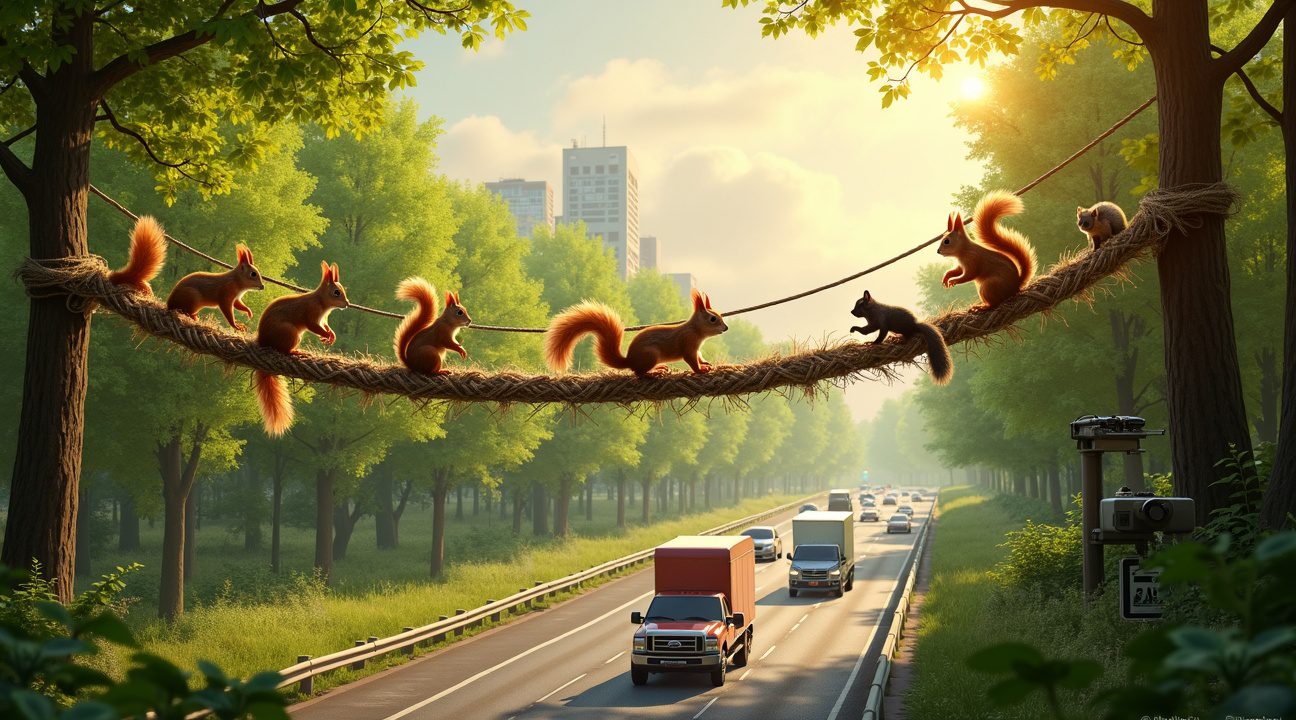
Why Squirrels Needed Years to Accept Their Custom Highway Bridge
When the Netherlands constructed a dedicated squirrel bridge over a busy highway, officials expected wildlife to embrace this crossing immediately. Reality delivered a different lesson entirely. I found that squirrels demonstrated remarkable caution, taking years to trust and utilize their custom infrastructure.
The Slow Start and Gradual Recognition
Initial monitoring revealed just how cautious these creatures could be. During the first two years of operation, wildlife cameras captured only five squirrel crossings total. This sparse usage continued well beyond the early period, with merely eleven crossings recorded over six years by 2018. Wildlife experts suspected that a single adventurous squirrel might have been responsible for multiple trips, making the actual adoption rate even lower than the numbers suggested.
The hesitant beginning didn’t indicate failure, however. Squirrels gradually began recognizing the bridge as a safe passage option. Each successful crossing likely reinforced confidence among the local population, creating a learning effect that spread through squirrel communities. Urban ecologist Esther Vogelaar declared the project “a big success” in 2022, highlighting how patience proved essential for wildlife infrastructure projects.
Understanding Natural Behaviors and Seasonal Patterns
Several factors influenced the bridge’s eventual acceptance by local wildlife populations. Seasonal behavior played a significant role in crossing patterns, with squirrels showing increased bridge usage during autumn months. This timing coincided perfectly with their natural foraging and hoarding behaviors, as squirrels frantically collect and store nuts for winter survival.
Predatory dynamics also shaped bridge usage patterns in unexpected ways. Pine martens, natural predators of squirrels, occasionally used the crossing as well. However, these two species rarely crossed simultaneously, creating an interesting ecological balance. Wildlife monitoring revealed that squirrels instinctively avoided the bridge when pine marten scent remained present, demonstrating their sophisticated survival instincts.
The slow adaptation process contrasted sharply with human expectations for immediate results. People often assume that providing infrastructure automatically leads to instant adoption, but wildlife operates on entirely different timescales. Animals must assess safety, establish new behavioral patterns, and pass learned behaviors through their communities before fully embracing human-made solutions.
Urban ecology research has shown that infrastructure projects requiring behavioral adaptation often take multiple seasons or years to show meaningful results. Squirrels needed time to incorporate the bridge into their mental maps of safe travel routes. Each generation of young squirrels learned bridge usage from their parents, gradually normalizing this crossing method within the population.
Environmental factors beyond predation influenced adoption rates as well. Weather conditions, traffic noise levels, and surrounding vegetation changes all affected squirrel comfort levels with the crossing. As vegetation matured around the bridge approaches, creating more natural corridor connections, usage rates improved noticeably.
The Netherlands’ patience with this project offers valuable lessons for wildlife management worldwide. Quick dismissal of seemingly underutilized wildlife infrastructure often prevents long-term success stories from developing. Modern monitoring technology allows researchers to track usage patterns accurately, providing data that supports continued investment in these projects.
Wildlife adaptation research demonstrates that successful infrastructure projects require understanding animal psychology, seasonal behaviors, and predator-prey relationships. The squirrel bridge’s journey from apparent failure to documented success illustrates why patience and persistence remain essential components of conservation efforts.
Current usage patterns suggest the bridge has become an established part of local squirrel behavior. Young squirrels now grow up knowing this crossing exists, making it a permanent feature of their territorial understanding. This generational learning ensures the bridge’s continued relevance for decades to come.
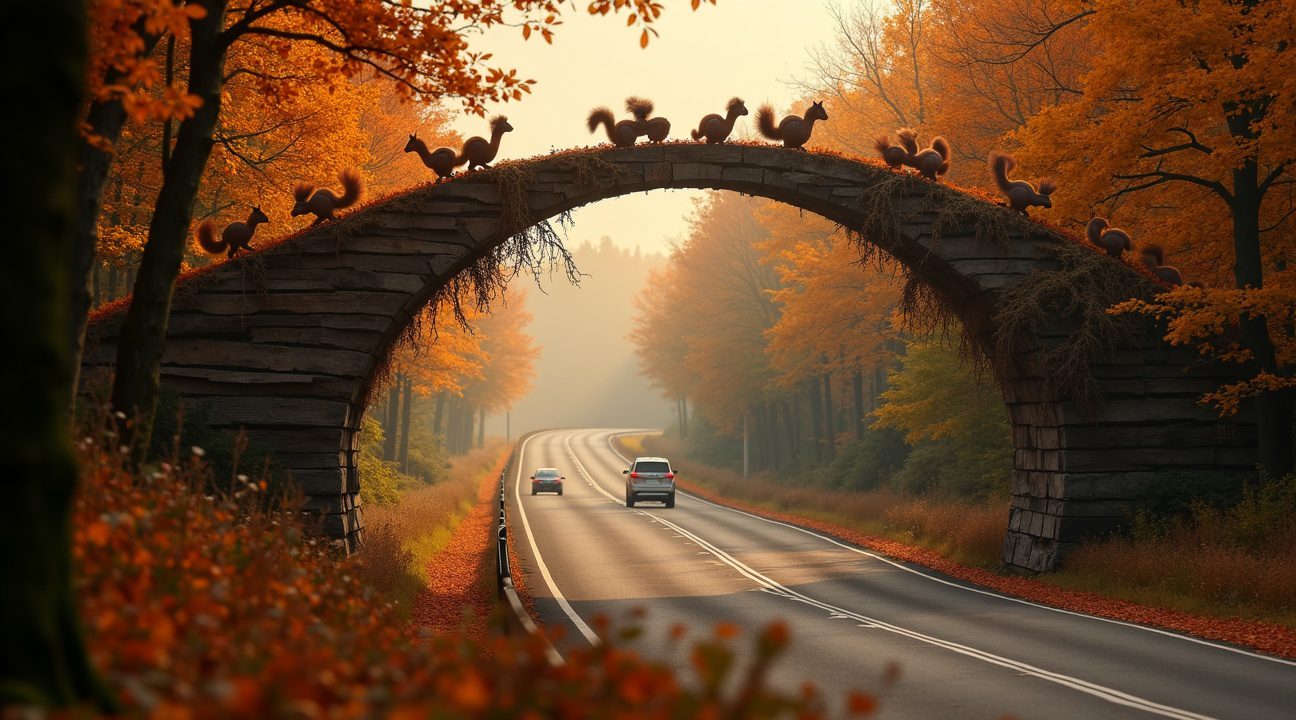
Engineering a Bridge for 2-Pound Animals Carrying Nuts
I find the engineering approach behind this squirrel bridge fascinating in its precision and consideration for such small animals. The cable-stayed structure represents a significant investment compared to simpler solutions implemented elsewhere in Europe, where basic rope crossings cost as little as €250 in Brecht, Belgium. Dutch engineers chose a far more sophisticated approach that prioritizes both safety and scientific monitoring capabilities.
Load Calculations and Impact Factors
Engineers faced unique challenges when calculating load requirements for animals weighing approximately 2 pounds. Standard bridge design principles don’t typically account for creatures carrying additional cargo, but squirrels regularly transport nuts and nesting materials across their territories. The design team developed a custom load factor that recommended tripling each squirrel’s weight to accommodate these carried items, demonstrating how innovative engineering solutions can address unexpected variables.
Impact load calculations proved equally challenging due to squirrels’ energetic movement patterns. Engineers applied an impact factor of approximately 100% of the live load—significantly higher than standard vehicular bridge considerations. This accounts for the dynamic nature of squirrel locomotion, including jumping, scrambling, and sudden directional changes that create forces beyond simple weight distribution.
The bridge incorporates advanced camera monitoring systems that serve dual purposes: tracking usage patterns and enabling scientific evaluation of the structure’s effectiveness. This monitoring capability allows researchers to validate their design assumptions while gathering data on squirrel behavior and crossing preferences. The integration of sophisticated monitoring technology transforms this wildlife infrastructure into a living laboratory.
Cable-stayed design offers distinct advantages for this application. The configuration provides the necessary span length while maintaining structural integrity under dynamic loads. Unlike suspension bridges, cable-stayed structures offer greater stiffness, which reduces movement that might discourage wildlife usage. The design also permits camera placement at optimal viewing angles without interfering with animal movement patterns.
This approach contrasts sharply with minimal rope crossing installations found throughout Europe. While those solutions serve their purpose, the Dutch implementation demonstrates how thoughtful engineering can create wildlife infrastructure that serves both immediate conservation needs and long-term research objectives. The additional investment in materials and monitoring systems positions this bridge as a model for future innovative transportation solutions that prioritize environmental integration alongside human mobility needs.
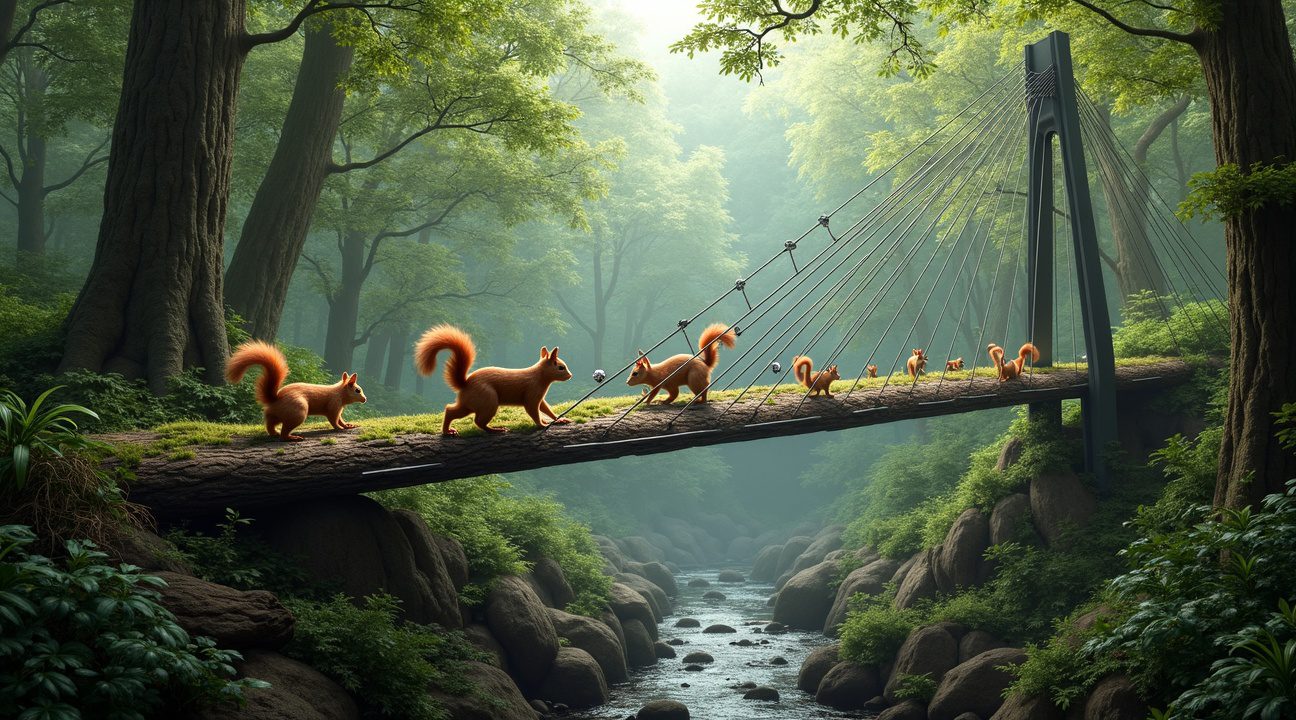
How the Dutch Bridge Compares to Squirrel Crossings Worldwide
The Netherlands’ innovative squirrel bridge stands as part of a growing global movement to protect small wildlife through specialized crossing infrastructure. Around the world, different countries have developed their own approaches to help squirrels safely traverse busy roadways, each reflecting local conditions and resources.
The Nutty Narrows Bridge in Longview, Washington, holds the distinction of being one of the earliest examples of dedicated squirrel infrastructure, constructed in 1963. This pioneering crossing demonstrated that communities could take practical action to protect local wildlife populations. Unlike the sophisticated Dutch engineering, American versions typically employ simpler, tree-anchored cable designs that require significantly lower construction costs while still providing effective passage for squirrels.
European Approaches to Wildlife Crossings
European nations have embraced rope-based wildlife crossings as cost-effective solutions for small mammals. Belgium recently made substantial investments in this infrastructure, installing 16 rope bridges during 2023 alone. These crossings operate at heights of approximately 10 meters and feature integrated camera monitoring systems to track usage patterns and wildlife behavior.
France, Germany, and the UK have similarly adopted rope-based crossing designs that balance functionality with budget considerations. These installations demonstrate how different engineering approaches can achieve the same conservation goals. The rope bridge model offers several advantages, including:
- Easier installation
- Lower maintenance requirements
- Ability to span various highway widths without extensive structural support
Camera monitoring systems have become increasingly important for understanding how effectively these crossings serve their intended purpose. Advanced technology allows researchers to document crossing patterns and adjust designs based on actual usage data. This scientific approach helps optimize future installations and demonstrates the real-world impact of wildlife crossing infrastructure.
The cost differential between approaches remains significant. While the Dutch bridge represents a premium engineering solution, simpler rope and cable systems prove that effective wildlife protection doesn’t always require major financial investment. Each country’s approach reflects local priorities, available funding, and specific environmental challenges.
Global comparison reveals that successful squirrel crossings share common elements regardless of their design complexity. Height placement, strategic location selection, and connection to existing tree canopies all contribute to crossing effectiveness. Innovation continues to drive new solutions as communities worldwide recognize the importance of maintaining wildlife corridor connectivity in increasingly developed landscapes.
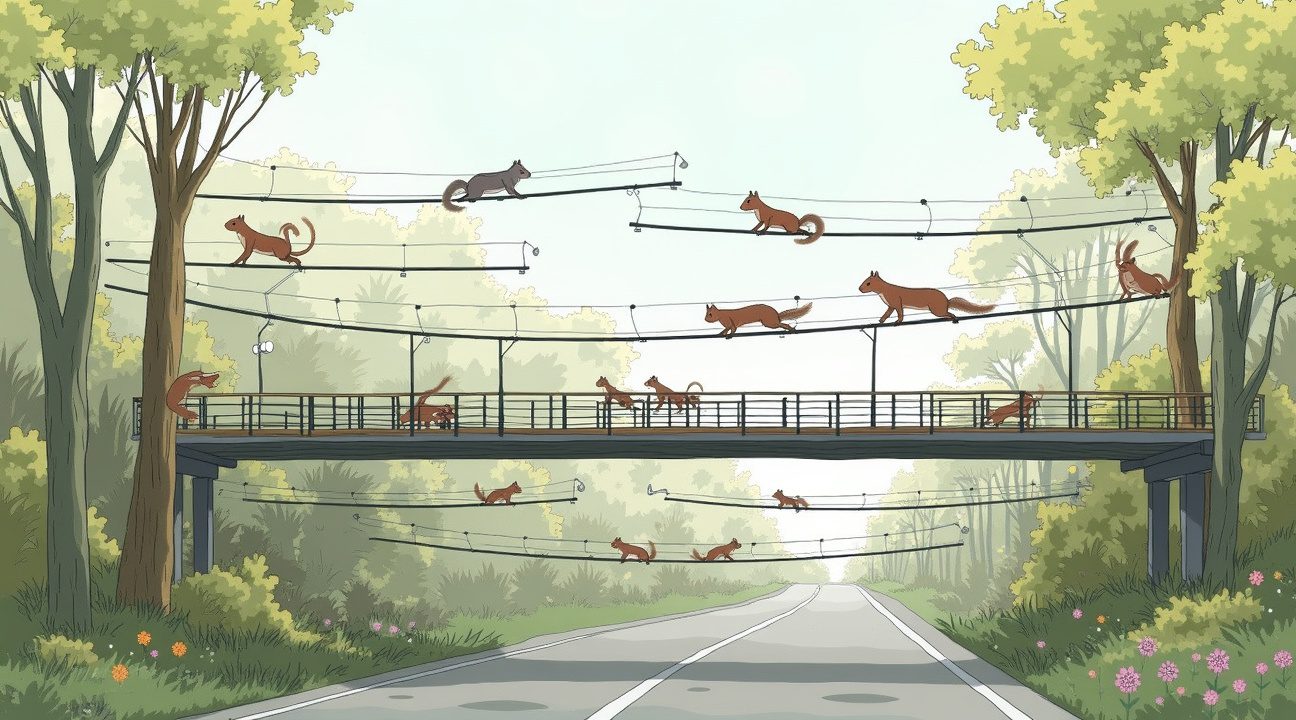
From Public Skepticism to Conservation Success Story
When the Netherlands announced plans for a specialized squirrel bridge crossing a major highway, taxpayers questioned whether such an expensive infrastructure project could justify its costs. Initial reactions centered around the substantial financial investment required for what appeared to be a niche conservation initiative. Critics argued that traditional wildlife protection methods might deliver better value for public funds.
The project’s primary goal focused on protecting red squirrels, a species facing increasing pressure from urban development and highway expansion. These small mammals had been cut off from essential food sources and breeding territories by the dangerous barrier of high-speed traffic. Highway crossings posed deadly risks, with many squirrels failing to reach the other side safely.
Evidence Changes Everything
Camera monitoring systems installed along the bridge began capturing compelling footage within months of completion. Documentation revealed consistent daily usage patterns, with red squirrels confidently traversing the structure multiple times per day. The recordings showed various wildlife species utilizing the corridor, including birds and small mammals that benefited from the protected crossing.
Media outlets that initially questioned the project’s wisdom began reporting positive outcomes. Television segments highlighted the bridge’s success through time-lapse photography showing regular animal traffic. These visual confirmations transformed public opinion from skepticism to genuine appreciation for the innovative approach to urban wildlife management. Stories spread about wildlife conservation efforts gaining momentum worldwide.
The ecological advantages extended beyond simple safe passage. Genetic diversity improved as previously isolated squirrel populations could now intermingle freely. Food source accessibility expanded dramatically, allowing animals to exploit resources on both sides of the highway without life-threatening journeys. This connectivity proved essential for maintaining healthy population dynamics across the urban landscape.
Motorist safety improvements became an unexpected bonus that strengthened public support. Vehicle-animal collisions decreased significantly in the bridge area, reducing insurance claims and preventing potentially serious accidents. Drivers appreciated fewer encounters with startled wildlife darting across busy lanes, while emergency response teams reported fewer animal-related incidents requiring intervention.
Urban planners began recognizing the bridge as a model for biodiversity enhancement strategies. The structure demonstrated how thoughtful infrastructure design could accommodate both human transportation needs and wildlife movement patterns. City officials noted increased property values in surrounding areas, where residents valued proximity to green corridors that supported local ecosystems.
Environmental scientists documented broader ecological benefits extending beyond the target species, including:
- Plant seeds carried by animals established vegetation connections across the landscape
- Pollinator movements increased, supporting flowering plants on both sides of the highway
- Eco-corridor development enhanced resilience in urban wildlife populations
Public investment discussions shifted from cost concerns to long-term value propositions. Economic analyses revealed that preventing vehicle accidents alone justified significant portions of the construction costs. Tourism increased as visitors came to observe the unique wildlife crossing, generating additional revenue for local businesses. Educational programs used the bridge as a teaching tool, inspiring similar innovative conservation projects in other regions.
The transformation in public perception reflected broader changes in environmental consciousness. Citizens began understanding that urban development could coexist with wildlife conservation through careful planning and investment. Success stories like the squirrel bridge helped build support for additional green infrastructure projects throughout the Netherlands.
International attention followed as conservation organizations highlighted the bridge as an example of practical biodiversity protection. Other countries began studying the design and implementation process, adapting similar concepts for their own wildlife protection needs. The project evolved from a local curiosity into a global reference point for urban ecology solutions.
Research continues documenting the bridge’s impact on local ecosystems. Scientists track population changes, movement patterns, and breeding success rates among bridge users. Data collection supports evidence-based decisions about future wildlife corridor investments, ensuring that public funds create maximum conservation value while maintaining broad community support for environmental protection initiatives.
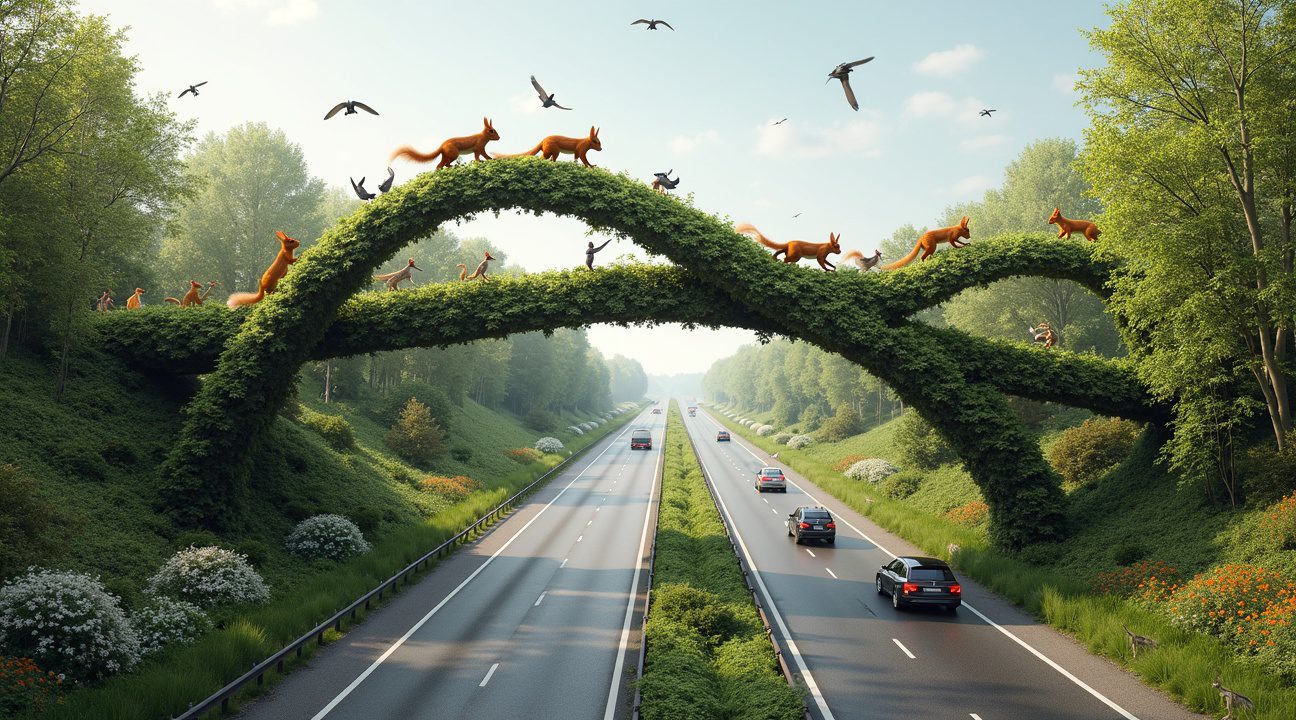
Sources:
DutchNews.nl
Komoot
Wikipedia
ASCE Civil Engineering Source

